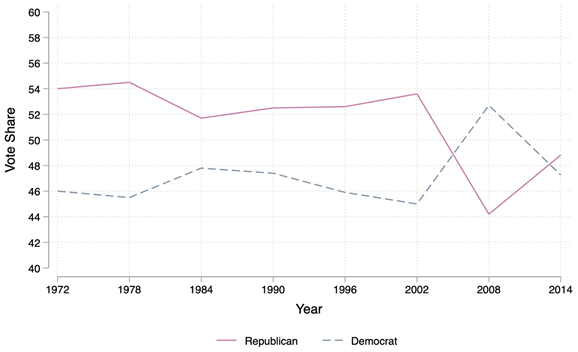 Many Americans have already begun voting in the 2020 election, not just for president, but for down-ballot races, such as for the US Senate. Chris Cooper looks at the race for North Carolina’s US Senate seat, writing that despite an early durable lead for Democratic challenger, Cal Cunningham, accusations of an extra-marital affair have given incumbent Republican Senator, Thom Tillis, an opportunity to disrupt his opponent’s lead.
Many Americans have already begun voting in the 2020 election, not just for president, but for down-ballot races, such as for the US Senate. Chris Cooper looks at the race for North Carolina’s US Senate seat, writing that despite an early durable lead for Democratic challenger, Cal Cunningham, accusations of an extra-marital affair have given incumbent Republican Senator, Thom Tillis, an opportunity to disrupt his opponent’s lead.
“This is—without a doubt—the most important Senate race in the nation.
— North Carolina Republican party email blast. August 28, 2020.
North Carolina is a hard state to figure out. From one perspective it looks positively Republican. After all, the General Assembly has a reputation for passing some of the most conservative policies in the country, and its US House delegation includes 10 Republicans and only three Democrats. From another perspective, it looks like a Democratic stronghold. Registered Democrats outnumber registered Republicans, Democratic Governor Roy Cooper was such a thorn in President Trump’s side that Trump was forced to cancel the Republican National Convention in Charlotte earlier this year, and the state has only had one Republican Attorney General in the last hundred years.
If figuring out North Carolina politics is akin to solving a puzzle, then predicting the outcome of the US Senate race in North Carolina is like trying to solve a Rubik’s cube after polishing off six beers from one of North Carolina’s 333 craft breweries. Just when things began to seem a little clearer in this race, two news stories have thrown a wrench in any thoughts that the race might be somewhat predictable.
A Brief History of the Seat
From 1901-1972 Democrats held North Carolina’s Class II Senate seat without interruption. This was, of course, common for the United States South at the time, which was then dominated by the Democratic Party. In 1972, however, the Democratic orthodoxy in North Carolina began to crack as Richard Nixon took North Carolina’s 13 electoral votes and staunch conservative Jesse Helms wrestled the Senate seat from Democratic control, besting congressional veteran Nick Galifinakis (uncle of actor Zach Galifinakis) by eight percentage points.
Helms held the seat from his election in 1972 through his retirement in 2002. Immediately after his retirement, the seat was filled by Republican Elizabeth Dole. Dole served just one term and was unseated by Democrat Kay Hagan in 2008. Hagan, too, only was unable to secure re-election, losing in 2014 to Republican Thom Tillis. As Figure 1 suggests, Tillis winning the 2014 election wasn’t a foregone conclusion, however. In fact, it was the closest result in recent North Carolina Senate history.
Figure 1 – North Carolina Class II Senate Seat Election Results 1972-2014

Enter 2020
Given the discordant recent history of the NC Class II Senate seat, Thom Tillis must have known that his re-election was a long way from guaranteed. Leading up to the election, Tillis was, at least according to one measure, the second least popular Class II US Senator in the country. Despite some early signs of trouble, he secured his party’s nomination easily, securing 78 percent of the vote and besting two primary opponents.
The Democratic nomination process was somewhat more in question. Frontrunner and former member of North Carolina’s General Assembly Cal Cunningham faced State Senator Erica Smith. Although Cunningham won the nomination, Smith garnered a respectable 35 percent of the vote and won almost a fifth of North Carolina’s 100 counties.
A Small, but Durable Lead
As the General Election campaign between Cunningham and Tillis kicked off, it became a marquee national race almost immediately and was often listed, along with Maine, Iowa, and Arizona, as one of the “core four” senate races that are most likely to determine control of the hotly contested United States Senate (currently the Republicans hold 53 seats).

“Welcome to North Carolina” by Taber Andrew Bain is licensed under CC-BY-2.0
Although it was generally considered a close race, Cunningham had a small but durable lead in most polls. Following the primary through to the end of September, the average poll showed a Cunningham lead of about 4.4 percentage points with 85 percent of the polls in that period showing a Cunningham lead. Cunningham’s astronomical fundraising numbers also cast the race as close, but the Democrat as the leader.
A Change to the Orthodoxy?
This month has welcomed an October surprise to the race that could upset the growing orthodoxy that Cunningham was likely to unseat Tillis. The first weekend in October saw a series of stories indicating that Cunningham had engaged in an extra-marital affair. At the same time, Thom Tillis was diagnosed with COVID-19. While the news cycle about Tillis’ diagnosis came and went fairly quickly, the stories about Cunningham’s affair continued as he seemed to avoid public appearances. The newspapers of the state capitol (Raleigh) and the largest city (Charlotte) published an editorial titled simply, “Explain Yourself, Cal Cunningham” where they urged the challenger to “stand up and be accountable.”
A series of polls released soon after the scandal broke demonstrated that despite the revelations and the media’s push to be more open, Cunningham’s lead remained virtually unchanged. Although his lead was stable, the results of these polls did not come without bad news for Cunningham. While they expressed the desire to vote for him, voters increasingly viewed Cunningham in less favorable terms than they had before the scandal broke. Thom Tillis attempted to capitalize on this October surprise, running a series of ads about Cunningham’s affair and calling into question his fitness for office.
Looking Forward
Given North Carolina’s status as neither red nor blue but rather solidly purple, no statewide race in North Carolina is a lock for either party. The state’s Senate race is no different. The small lead that Cunningham enjoyed through September appears to still be durable—at least in terms of public opinion polling, although Thom Tillis continues to attempt to disrupt that lead in every way possible. As we enter the final stretch of the campaign, when more than one million voters have already cast their vote, questions abound about whether Cunningham can defend his lead against Tillis’ accusations and increasingly negative campaigning. For his part, Cunningham’s strategy is clear: focus attention on policy issues, and limit his exposure. It’s too early to know which strategy will be the most effective, but it’s not a stretch to say that whoever prevails will have provided the key victory in determining control of the United States Senate.
Please read our comments policy before commenting.
Note: This article gives the views of the author, and not the position of USAPP – American Politics and Policy, nor the London School of Economics.
Shortened URL for this post: https://bit.ly/35hToow
About the author
 Christopher A. Cooper – Western Carolina University
Christopher A. Cooper – Western Carolina University
Christopher A. Cooper is Robert Lee Madison Distinguished Professor and Department Head in the Department of Political Science and Public Affairs at Western Carolina University. His research focuses on state and local politics, North Carolina politics, southern politics and elections in the United States.







Please correct your spelling of JESSE Helns—there is no “i” in his name.
Hi Chuck,
Thanks for spotting that typo. It’s now been corrected.
– Chris Gilson, Managing Editor, LSE USAPP blog